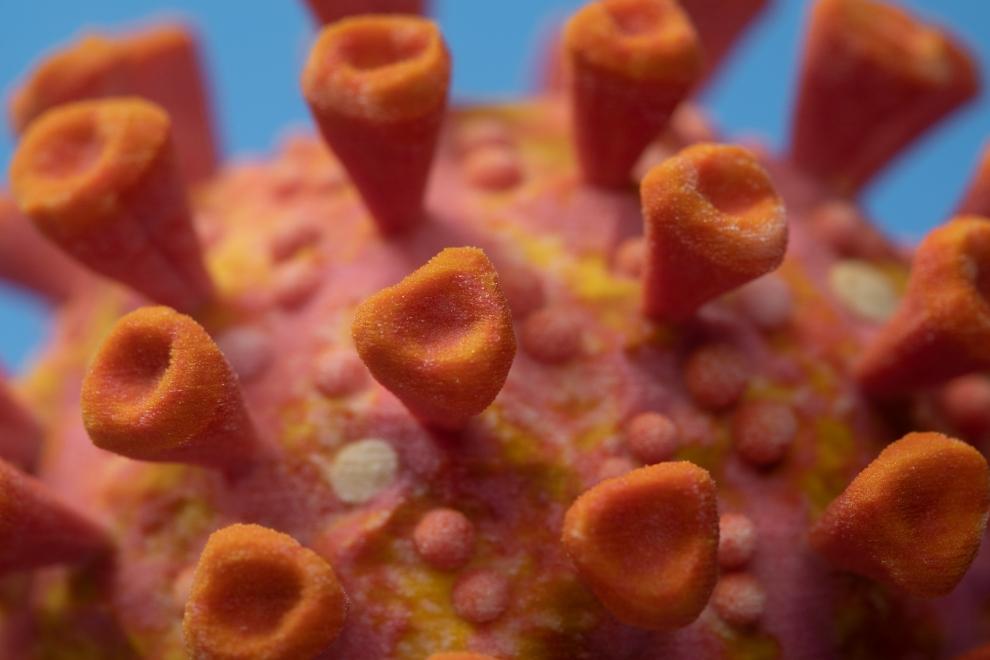- FMA
- The Fabricator
- FABTECH
- Canadian Metalworking
Our Publications
Categories
- Additive Manufacturing
- Aluminum Welding
- Arc Welding
- Assembly and Joining
- Automation and Robotics
- Bending and Forming
- Consumables
- Cutting and Weld Prep
- Electric Vehicles
- En Español
- Finishing
- Hydroforming
- Laser Cutting
- Laser Welding
- Machining
- Manufacturing Software
- Materials Handling
- Metals/Materials
- Oxyfuel Cutting
- Plasma Cutting
- Power Tools
- Punching and Other Holemaking
- Roll Forming
- Safety
- Sawing
- Shearing
- Shop Management
- Testing and Measuring
- Tube and Pipe Fabrication
- Tube and Pipe Production
- Waterjet Cutting
Industry Directory
Webcasts
Podcasts
FAB 40
Advertise
Subscribe
Account Login
Search
Coping with COVID-19
How would we respond to the coronavirus without social distancing, the internet—and 3D printing?
- By Kip Hanson
- April 22, 2020

Close-up view of the virus that causes COVID-19, printed by the 3D Anatomic Modeling Lab at Mayo Clinic. Mayo Clinic
Over the past month, I’ve participated in a dozen or so Zoom meetings, including the “Four-State Virtual Happy Hour” that I organized for family and friends. I’ve exchanged a total of 1,306 emails, not counting the ones I deleted (it seems the pandemic hasn’t affected spammers selling replacement windows and skincare products).
And if you’ve been keeping up with The Additive Report, you know that I’ve spoken with several 3D printing firms who’ve been busy making PPE and other critical medical components. (Canadian makers 3D-print PPE. 3D printing club produces face shields. Idaho print farm builds 1,000 face shields a day.)
Hats off to one and all.
While chatting with one shop owner, a simple yet terrifying question arose: Where would we be if all this had happened 40 years ago? Yes, I know that’s a difficult concept to grasp for all the Millennials and Gen-Xers reading this, for whom the internet and social media are accepted parts of life. But for those of us who grew up with black-and-white TVs and rotary phones, it’s abundantly clear that life would be far different if the coronavirus had emerged during the Carter presidency.
There was no such thing as telecommuting in 1980. You went to work, you went on vacation, or you stayed home sick. The only mail was that delivered by the United States Postal Service. I suppose you could have called the grocery store and asked them to box up some eggs and milk for you, although I’m not sure who would have delivered it. One constant is hand-sanitizer—there wasn’t any available back then, either, as it had yet to be invented.
And there wasn’t any 3D printing. The only rapidly manufactured parts were those made on knee mills and engine lathes. Shops and hobbyists weren’t printing PPE. The only way to produce any plastic components was via injection molding, using tooling that required months to design and manufacture.
The point is this: Without social distancing, the internet, and the 3D-printed parts that help keep our healthcare workers safe, our current pandemic would probably resemble the Spanish Flu outbreak of 1918, during which one-third of the world's population—500 million people—became infected and 50 million died, including 675,000 in the U.S.
Granted, today’s healthcare is far more advanced than that of the post-World War I era, but we also have air travel, cities of 10 million people, and five times the world population. And, to top it off, the coronavirus appears to be far more deadly than the H1N1 of 100 years ago. Do the math and you’ll find the numbers staggering.We’ll get through this. Until then, stay strong, be patient, wash your hands, and continue giving thanks to those who are trying to help.
About the Author

Kip Hanson
About the Publication
- Podcasting
- Podcast:
- The Fabricator Podcast
- Published:
- 04/30/2024
- Running Time:
- 53:00
Seth Feldman of Iowa-based Wertzbaugher Services joins The Fabricator Podcast to offer his take as a Gen Zer...
- Trending Articles
- Industry Events
Pipe and Tube Conference
- May 21 - 22, 2024
- Omaha, NE
World-Class Roll Forming Workshop
- June 5 - 6, 2024
- Louisville, KY
Advanced Laser Application Workshop
- June 25 - 27, 2024
- Novi, MI
Precision Press Brake Certificate Course
- July 31 - August 1, 2024
- Elgin,


























